GRDF and the Digitization of Reporting

How can digital technology make it easier for territories to control their operators's activities? What is its impact on their relationship? Let's answer these questions.
As some of you may know, the right to produce natural gas is granted in the form of concessions. Municipalities or groups of municipalities give GRDF (among others) permission to operate their gas distribution facilities and collect transportation revenues. These activities are regularly monitored by the local authorities. Today, we’ll be looking at the ways in which this monitoring can be optimized.
I spoke with Damien Escot, Concessions Manager at GRDF, to learn more about this subject. How do municipalities monitor their gas distribution networks? How can digital technology facilitate this monitoring and benefit gas concessions? Let’s find out together!
A platform for reporting
Damien is a member of the Corporate Functions Team at GRDF. He supports and manages the regional teams that act as liaisons between the network and the granting authorities. “One of our jobs is to report on our activities,” Damien explains. “This involves drafting an annual report, a 120-page document in which we inventory the concession’s facilities, its customers, any incidents that have occurred, the amount of gas that has been transported, etc.”.
A few years ago, this massive document was reinforced by a data sharing platform called “Ma Concession Gaz” (“My Gas Concession”). “We decided to use this service in 2014 after discussing ways to develop our concession activity report.”
The first tests were completed in 2016-2017 with Opendatasoft (GRDF was already collaborating with us on its open data project), and the platform then took a few years to become operational. “We set up complex security systems that made it difficult to access the portal indirectly.” The teams also took the time to produce a reliable set of data. “We had to create data sets that were consistent with our activity report, which contained a few million lines of data,” adds Damien.
A platform that benefits everyone
After a few tweaks, the tool really took off in 2019 and demonstrated its full potential.
The main purpose of the “Ma Concession Gaz” platform is to provide municipalities with greater control over the concessions. “Before the emergence of the platform, we used to receive detailed “shopping lists” from the grantors of concessions. Our teams would then prepare an elaborate report to meet their needs,” explains Damien. What has changed since they started using the platform? “80 to 90% of the data for the past year, as well as for the two previous years, is now accessible at any time via the platform starting on June 1st.”
For GRDF, this data sharing platform is the perfect way to increase its transparency. “A few years ago, rumor had it that the local authorities had given up control and that concession companies were taking advantage of the situation.” Today, relations have improved and trust has been restored. “Our new way of functioning allows us to demonstrate our good will and our total transparency.”
The platform also led to changes within GRDF itself: “Previously, data was produced by regional teams, each with its own special expertise. Today, data is made available on the national level, allowing for it to be processed in a more uniform manner.” The new system also makes it possible for regional teams to spend more time on analysis and on relations with grantors. “We’re in the process of industrializing the production and provision of data. A win-win for everyone involved,” Damien concludes.
A constantly evolving platform
GRDF’s approach has been welcomed and praised by grantors, even if the latter continue to encourage the company to improve its system.
Here are some of the upcoming challenges for Damien and his teams:
- Expand the range and detail of their data.
- Make data sets available for mass export. Concession grantors have asked GRDF to come up with a way to let them export all the platform’s data sets (around 60) with just one click. “We sat down with ODS and their service provider Umami Workshop to develop an API that makes this type of mass export possible. The API will be available on June 1st of next year, following the publication of the results of the previous fiscal year.”
- Keep the portal open at all times. “We hope to be able to add the data from the new fiscal year as it emerges, without it being accessible to communities before its official publication. As it stands today, we are forced to shut down the platform during the month of May to add the data.” GRDF and ODS are currently working on a solution to make this a reality.
- Combine industrialization and personalization. GRDF seeks to limit access to certain data sets to a few selected grantors. “We have successfully industrialized the production of our data and now hope to focus more on personalization.”
- Improve the cohesion between the annual report and the platform. Damien and his teams hope to link the summary document to the data sets on the platform. For example, “by clicking on an investment table in the report, the user might be taken directly to the data set that corresponds to the details of the investment.”
The “Ma Concession Gaz” platform goes hand in hand with new ways of working. Thanks to this new system, GRDF has reinforced its reputation amongst concession grantors as a trustworthy company, all the while increasing its transparency. The platform also saves data producers precious time and gives grantors the luxury of accessing information autonomously. The platform will continue to receive some finishing touches in the next few years, and this is exactly what motivates Damien. “The best part of my job is that it’s always changing. I get to test new tools and constantly make improvements to existing systems. I love being challenged by feedback from users and then finding ways to satisfy their needs and demands.”
See you back here soon for more “datadventures!”

Access to accurate statistical information is key to the successful functioning of the global economy and for policymakers and businesses to make informed decisions around subjects that impact us all. How can institutions effectively and efficiently share their statistical data in an interoperable, scalable way to democratize access and build trust?

Data portals need to demonstrate their impact and meet user needs by providing the right data assets to generate reuse. We explore how our customers are using the Opendatasoft data lineage feature to analyze portal performance and continually improve the experience they provide.

Opendatasoft has launched its unique, innovative data lineage feature. Focused on usage, it allows organizations to better understand how their data is used internally and externally, across data ecosystems, while improving the ease and efficiency of data portal management.
